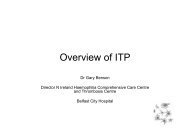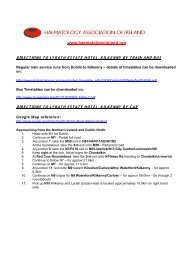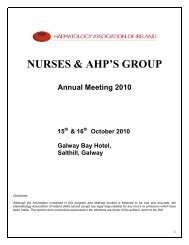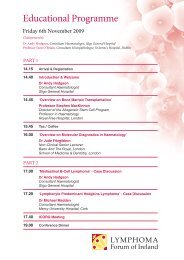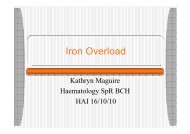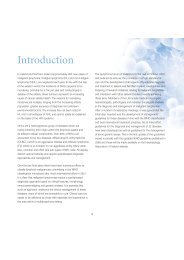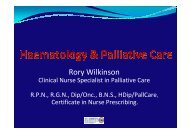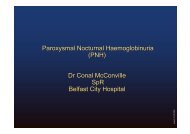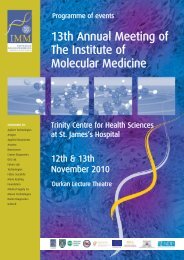Guidelines on Diagnosis and Treatment of Malignant Lymphomas
Guidelines on Diagnosis and Treatment of Malignant Lymphomas
Guidelines on Diagnosis and Treatment of Malignant Lymphomas
Create successful ePaper yourself
Turn your PDF publications into a flip-book with our unique Google optimized e-Paper software.
Pathologic <strong>Diagnosis</strong><br />
<strong>of</strong> Lymphoma<br />
General comments<br />
1. Primary diagnosis<br />
a. Complete lymph node excisi<strong>on</strong> in the presence <strong>of</strong> nodal<br />
disease is the optimum diagnostic material <strong>and</strong> should be<br />
utilised wherever possible. *<br />
b. The complete lymph node excisi<strong>on</strong> should be transported<br />
immediately in a fresh state to the laboratory.<br />
c. The fresh lymph node should be h<strong>and</strong>led as per algorithm<br />
<strong>on</strong> page 15.<br />
d. *Where full lymph node excisi<strong>on</strong> is not possible e.g.<br />
inaccessible mass or extranodal disease, core biopsy is the<br />
next best opti<strong>on</strong> for accurate primary diagnosis unless a<br />
resecti<strong>on</strong> has been or will be undertaken. Multiple large<br />
cores should ideally be submitted fresh to the laboratory <strong>on</strong><br />
saline soaked gauze otherwise they should be submitted in<br />
10% buffered formalin.<br />
e. All cases must be received with relevant clinical informati<strong>on</strong>.<br />
2. The role <strong>of</strong> Flow Cytometry (FCM)<br />
a. FCM is useful for accurate diagnosis in all small cell /<br />
follicular pattern lesi<strong>on</strong>s.<br />
b. FCM <strong>on</strong> aspirated material may provide a reas<strong>on</strong>able<br />
alternative to biopsy in recurrent disease where tissue is<br />
not easily obtainable e.g. elderly/frail patient, inaccessible<br />
site. Such FNA samples require co-ordinati<strong>on</strong> with the<br />
laboratory as special fixati<strong>on</strong> (RPMI) <strong>and</strong> immediate<br />
processing is required<br />
3. Optimum h<strong>and</strong>ling <strong>of</strong> fresh lymph node excisi<strong>on</strong><br />
a. Ensure immediate transfer from the theatre to laboratory.<br />
b. Bisect node <strong>and</strong> perform touch preparati<strong>on</strong>s.<br />
i. Air dried x 2 – Giemsa stain<br />
ii. Air dried X6-8 FISH studies if required<br />
iii. Fixed x 2 – H & E stain<br />
c. Sample porti<strong>on</strong> <strong>of</strong> tissue for:<br />
i. Freezing – 1 porti<strong>on</strong> in “RNA later”, 1 porti<strong>on</strong> fresh<br />
frozen (this will preserve material for molecular study<br />
should this be required).<br />
ii. RPMI for FCM (this will preserve the cells <strong>and</strong> allow<br />
transport to nearest centre <strong>of</strong>fering FCM <strong>and</strong>/or<br />
Cytogenetics service).<br />
iii. Formalin for routine fixati<strong>on</strong> <strong>and</strong> processing.<br />
4. Classificati<strong>on</strong> <strong>and</strong> grading<br />
a. Use WHO classificati<strong>on</strong> 4th editi<strong>on</strong> 2008<br />
b. Where applicable use WHO grading e.g.<br />
Follicular Lymphoma (see page 29)<br />
5. The role <strong>of</strong> FCM/Cytogenetics/<br />
Gene expressi<strong>on</strong> pr<strong>of</strong>iling<br />
Material should be preserved in RPMI <strong>and</strong> frozen<br />
for availability for cytogenetic analysis <strong>and</strong> other<br />
relevant evaluati<strong>on</strong><br />
6



